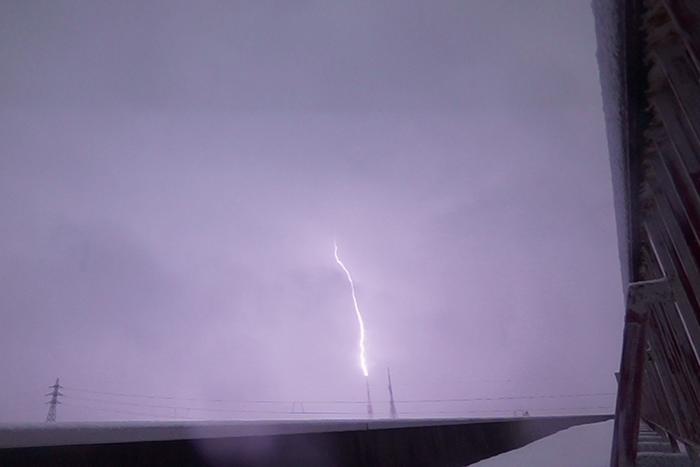
In a landmark advancement for atmospheric science, researchers at The University of Osaka have unveiled unprecedented observations that illuminate one of nature’s most enigmatic phenomena—terrestrial gamma-ray flashes (TGFs) linked to lightning strikes. Published in the esteemed journal Science Advances, this study presents the first-ever synchronized detection of an intense burst of gamma radiation coinciding precisely with lightning discharges, a discovery that may revolutionize our understanding of high-energy processes occurring within Earth’s atmosphere.
Lightning, a dramatic electrostatic discharge that dazzles the skies and commands both reverence and apprehension, has long baffled scientists with its complex internal dynamics and energetic behaviors. While meteorological studies have extensively cataloged its electrical characteristics, the mechanisms by which lightning generates potent bursts of gamma rays—particles of electromagnetic radiation typically associated with cosmic events such as supernovae and black hole jets—have remained largely speculative. The Osaka team offers compelling empirical evidence linking the fleeting gamma emissions to the intricate interaction between opposing lightning leaders.
Terrestrial gamma-ray flashes are transient phenomena lasting merely microseconds, emitting radiation at energies millions of times higher than visible light. The quick tempo and high energy of TGFs pose extreme observational challenges, requiring cutting-edge instrumentation capable of simultaneously capturing rapid optical, electromagnetic, and high-energy signals. The researchers deployed a sophisticated multi-sensor array in Kanazawa City, Ishikawa Prefecture, integrating optical cameras, radio-frequency antennas, and gamma-ray detectors to capture the multifaceted nature of the lightning event with unparalleled temporal precision.
Crucially, the study documents two lightning leader channels operating in opposition—one descending from the storm cloud towards a ground-based transmission tower, and the other ascending from the tower itself. As these leaders extended toward each other, the researchers detected a terrestrial gamma-ray flash commencing 31 microseconds before their collision. This flash persisted for another 20 microseconds post-contact, underscoring a complex interplay between electric fields and particle acceleration that transcends prior theoretical models.
The physics underlying these gamma-ray bursts emanate from the formation of extraordinarily intense localized electric fields where the leader channels converge. Such fields possess the capacity to accelerate electrons in air to velocities approaching the speed of light. These relativistic electrons then generate gamma photons through a process akin to bremsstrahlung radiation, whereby the rapid deceleration or deflection of charged particles produces high-energy radiation. This confirmation supports longstanding hypotheses about the role of runaway electrons in atmospheric high-energy phenomena, firmly placing lightning within the realm of relativistic plasma physics.
By observing a discharge current of negative polarity peaking at approximately −56 kiloamperes following the leader collision, the findings highlight the immense electrical energies involved in these interactions. The dataset not only chronicles the temporal alignment of radiation and electrical signals but also provides granular insight into the electrodynamic processes that govern leader formation, propagation, and fusion. These results enrich the theoretical framework surrounding lightning physics, particularly regarding the enigmatic mechanisms permitting terrestrial environments to momentarily mimic astrophysical particle accelerators.
Beyond theoretical implications, this research bears significant practical relevance. Understanding the generation and propagation of TGFs is vital for assessing radiation exposure risks to aircraft, satellites, and ground-based infrastructure. High-energy radiation from lightning can induce electronic malfunctions or degradation, posing safety challenges. By decoding the conditions that foster such bursts, this study paves the way for enhanced predictive models and mitigation strategies that bolster resilience against atmospheric radiation hazards.
Moreover, the pioneering multi-modal sensor technique represents a transformative methodological leap, enabling simultaneous, high-resolution captures of optical, radio, and gamma-ray signals during fleeting atmospheric events. This integrative approach promises to unravel other transient energetic phenomena within Earth’s atmosphere, opening new frontiers in space-weather research and atmospheric electricity. Future deployments and wider data collection will likely refine models and uncover additional, as-yet-undetected radiation mechanisms linked to weather systems.
Senior author Harufumi Tsuchiya remarked on the breakthrough, emphasizing that while mysteries endure in understanding lightning’s full complexity, this research marks a fundamental stride towards decoding the physics of lightning-associated radiation bursts. These findings challenge researchers to reconsider the boundaries between atmospheric and cosmic high-energy phenomena, reframing lightning not just as a meteorological event but as a laboratory for relativistic particle physics.
The implications extend to the design and reinforcement of telecommunication towers and other critical installations vulnerable to intense electric discharges. Detailed knowledge of lightning leader dynamics and associated radiation fluxes informs engineering practices aimed at minimizing downtime, damage, and risk to human operators. Integrating radiation monitoring with lightning detection systems could become a cornerstone for infrastructure safety in lightning-prone regions.
This study also spotlights the broader scientific importance of Japan’s commitment to innovation and advanced atmospheric research, with The University of Osaka leveraging state-of-the-art technology and inter-disciplinary collaboration. Supported by the Japan Society for the Promotion of Science, this work exemplifies how fundamental scientific inquiry, blended with technological prowess, can address long-standing natural mysteries while delivering societal benefits.
The upcoming publication titled “Downward Terrestrial Gamma-ray Flash Associated with Collision of Lightning Leaders” promises to catalyze further research efforts worldwide. As observational capacities improve, the scientific community anticipates richer datasets and nuanced theoretical models that will reshape our understanding of natural high-energy processes, bridging atmospheric phenomena with astrophysical contexts.
In sum, this breakthrough not only demystifies the transient, high-energy gamma rays produced in lightning but also heralds a new era of multi-disciplinary atmospheric science. By decoding how particles accelerate under Earth’s stormy skies, it invites us to view lightning through a relativistic lens—highlighting nature’s extraordinary ability to harness and unleash energies rivaling the cosmos itself.
Subject of Research: Not applicable
Article Title: “Downward Terrestrial Gamma-ray Flash Associated with Collision of Lightning Leaders”
News Publication Date: 21-May-2025
Web References: https://doi.org/10.1126/sciadv.ads6906
References:
Downward Terrestrial Gamma-ray Flash Associated with Collision of Lightning Leaders, Science Advances, DOI: 10.1126/sciadv.ads6906
Image Credits: Yuuki Wada
Keywords
Lightning, Weather, Gamma ray bursts, Electromagnetic waves, Radiowaves, Storms
Tags: atmospheric science breakthroughschallenges in observational scienceelectromagnetic radiation studieselectrostatic discharge dynamicsgamma-ray burstshigh-energy processes in Earth’s atmospherelightning and gamma radiationlightning strike phenomenasynchronized detection of gamma raysterrestrial gamma-ray flashestransient gamma-ray emissionsUniversity of Osaka research





